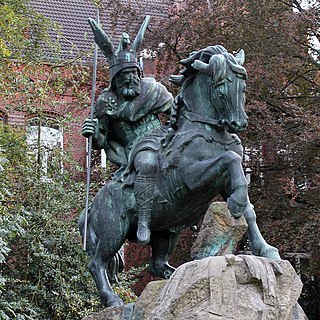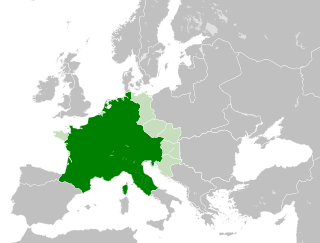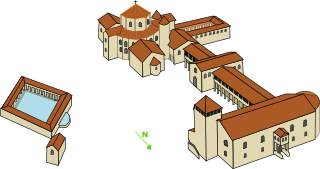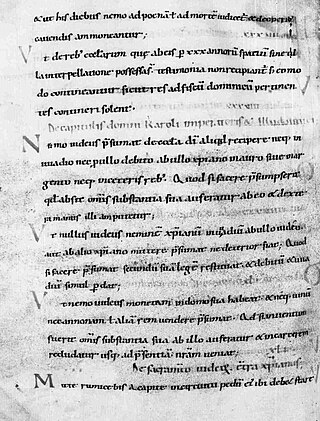Related Research Articles

Charlemagne was King of the Franks from 768, King of the Lombards from 774, and Emperor of what is now known as the Carolingian Empire from 800, holding all these titles until his death in 814. Charlemagne succeeded in uniting the majority of Western and Central Europe, and was the first recognized emperor to rule in the west after the fall of the Western Roman Empire approximately three centuries earlier. Charlemagne's rule saw a program of political and social changes that had a lasting impact on Europe in the Middle Ages.
The 780s decade ran from January 1, 780, to December 31, 789.

Year 782 (DCCLXXXII) was a common year starting on Tuesday of the Julian calendar, the 782nd year of the Common Era (CE) and Anno Domini (AD) designations, the 782nd year of the 1st millennium, the 82nd year of the 8th century, and the 3rd year of the 780s decade. The denomination 782 for this year has been used since the early medieval period, when the Anno Domini calendar era became the prevalent method in Europe for naming years.

Widukind, also known as Wittekind and Wittikund, was a leader of the Saxons and the chief opponent of the Frankish king Charlemagne during the Saxon Wars from 777 to 785. Charlemagne ultimately prevailed, organized Saxony as a Frankish province, massacred thousands of Saxon nobles, and ordered conversions of the pagan Saxons to Christianity. In later times, Widukind became a symbol of Saxon independence and a figure of legend. He is also venerated as a blessed in the Catholic Church.

The Carolingian Empire (800–887) was a Frankish-dominated empire in Western and Central Europe during the Early Middle Ages. It was ruled by the Carolingian dynasty, which had ruled as kings of the Franks since 751 and as kings of the Lombards in Italy from 774. In 800, the Frankish king Charlemagne was crowned emperor in Rome by Pope Leo III in an effort to transfer the Roman Empire from the Byzantine Empire to Western Europe. The Carolingian Empire is sometimes considered the first phase in the history of the Holy Roman Empire.

The Carolingian Renaissance was the first of three medieval renaissances, a period of cultural activity in the Carolingian Empire. Charlemagne's reign led to an intellectual revival beginning in the 8th century and continuing throughout the 9th century, taking inspiration from ancient Roman and Greek culture and the Christian Roman Empire of the fourth century. During this period, there was an increase of literature, writing, visual arts, architecture, music, jurisprudence, liturgical reforms, and scriptural studies. Carolingian schools were effective centers of education, and they served generations of scholars by producing editions and copies of the classics, both Christian and pagan.
The Massacre of Verden was an event during the Saxon Wars where the Frankish king Charlemagne ordered the death of 4,500 Saxons in October 782. Charlemagne claimed suzerainty over Saxony and in 772 destroyed the Irminsul, an important object in Saxon paganism, during his intermittent thirty-year campaign to Christianize the Saxons. The massacre occurred in Verden in what is now Lower Saxony, Germany. The event is attested in contemporary Frankish sources, including the Royal Frankish Annals.

Willehad or Willihad ; c. 745 AD – 8 November 789) was a Christian missionary and possibly the Bishop of Bremen from 787 AD.

Donar's Oak was a sacred tree of the Germanic pagans located in an unclear location around what is now the region of Hesse, Germany. According to the 8th century Vita Bonifatii auctore Willibaldo, the Anglo-Saxon missionary Saint Boniface and his retinue cut down the tree earlier in the same century. Wood from the oak was then reportedly used to build a church at the site dedicated to Saint Peter. Sacred trees and sacred groves were widely venerated by the Germanic peoples.
A capitulary was a series of legislative or administrative acts emanating from the Frankish court of the Merovingian and Carolingian dynasties, especially that of Charlemagne, the first emperor of the Romans in the west since the collapse of the Western Roman Empire in the late 5th century. They were so called because they were formally divided into sections called capitula.

The Saxon Wars were the campaigns and insurrections of the thirty-three years from 772, when Charlemagne first entered Saxony with the intent to conquer, to 804, when the last rebellion of tribesmen was defeated. In all, 18 campaigns were fought, primarily in what is now northern Germany. They resulted in the incorporation of Saxony into the Frankish realm and their forcible conversion from Germanic paganism to Christianity.

The Limes Saxoniae, also known as the Limes Saxonicus or Sachsenwall, was an unfortified limes or border between the Saxons and the Slavic Obotrites, established about 810 in present-day Schleswig-Holstein.
The Lex Saxonum are a series of laws issued by Charlemagne between 782 and 803 as part of his plan to subdue the Saxon nation. The law is thus a compromise between the traditional customs and statutes of the pagan Saxons and the established laws of the Frankish Empire.
Thrasco was the Prince (knyaz) of the Obotrite confederation from 795 until his death in 810. He succeeded his father, Witzlaus II, who had been ambushed and killed by the revolting Saxons. Thrasco defeated the Saxons in the battle on Schwentine River in 798. He was murdered in Reric in 810. Thrasco had a son, Cedragus, the Obotrite prince from 819 to 826.

The Palace of Aachen was a group of buildings with residential, political, and religious purposes chosen by Charlemagne to be the center of power of the Carolingian Empire. The palace was located north of the current city of Aachen, today in the German Land of North Rhine-Westphalia. Most of the Carolingian palace was built in the 790s but the works went on until Charlemagne's death in 814. The plans, drawn by Odo of Metz, were part of the program of renovation of the kingdom decided by the ruler. Today much of the palace is ruined, but the Palatine Chapel has been preserved and is considered a masterpiece of Carolingian architecture and a characteristic example of architecture from the Carolingian Renaissance.
The Council of Paderborn of 785 was an important piece in the Christianization of the Saxons and aided in establishing a short lived peace by force between the Saxons and Franks. It resolved to make punishable by law all sorts of idolatry, the belief in the existence of witchcraft, causing the deaths of others through witch-hunting, and more.

The Capitulary for the Jews is a set of six short legal prescriptions concerning Jews in the Carolingian Empire. They were gathered together and published under the title by which they are now known by Alfred Boretius in 1883, but only the first three and possibly the fourth are derived from a single source; the fifth and sixth are from an unrelated source. In one manuscript, the sixth "chapter" (capitulum) is said to have been taken "from Emperor Charles' statutes", indicating either Charlemagne or Charles the Bald. Its content, however, is inconsistent with the known Jewish policies of these emperors.
Lüne was a location on the left bank of the lower Elbe, known in connection with the Saxon war of 795. It was a village near Lüneburg.
The Carmen de conversione Saxonum—or in English, Poem Concerning the Conversion of the Saxons—is a Latin poem celebrating the conversion of the Saxons to Christianity in 777. It was written by a poet of the Frankish Kingdom for or shortly after the assembly held by Charlemagne at Paderborn in Saxony in that year. This marked the end of the first phase of the Saxon Wars and was believed at the time, as shown by the Carmen and other contemporary sources, to mark the full acceptance by the Saxons of their defeat and conversion. The following year, however, the Saxons rebelled and the wars continued for several decades.
The Carolingian Church encompasses the practices and institutions of Christianity in the Frankish kingdoms under the rule of the Carolingian dynasty (751-888). In the eighth and ninth centuries, Western Europe witnessed decisive developments in the structure and organisation of the church, relations between secular and religious authorities, monastic life, theology, and artistic endeavours. Christianity was the principal religion of the Carolingian Empire. Through military conquests and missionary activity, Latin Christendom expanded into new areas, such as Saxony and Bohemia. These developments owed much to the leadership of Carolingian rulers themselves, especially Charlemagne and Louis the Pious, whose courts encouraged successive waves of religious reform and viewed Christianity as a unifying force in their empire.
References
- ↑ For example, Pierre Riché (1993:105) renders the Latin as 'Ordinances concerning Saxony', whereas Ingrid Rembold translates the phrase as 'Saxon Capitularies' or Saxon Capitulary' (Rembold 2018: 25)
- ↑ Hen (2006).
- ↑ Michael Frassetto (14 March 2013). The Early Medieval World: From the Fall of Rome to the Time of Charlemagne [2 Volumes]. ABC-CLIO. pp. 489–. ISBN 978-1-59884-996-7.
- ↑ Munro (2004:2).
- ↑ "Capitulatio de Partibus Saxoniae". Jassa. Retrieved 3 January 2022.
- ↑ Riché (1993:105).
- ↑ "Germany – Charlemagne". Encyclopedia Britannica. Retrieved 3 June 2018.
Sources
- Hen, Yitzhak (2006). Charlemagne's Jihad (Thesis). Ben-Gurion University of the Negev.
- Munro, Dana Carleton (2004). Selections from the Laws of Charles the Great. Kessinger Publishing. ISBN 978-1-4179-6511-3.
- Riché, Pierre (1993). The Carolingians. University of Pennsylvania Press. ISBN 978-0-8122-1342-3.
- Rembold, Ingrid (2018). Conquest and Christianization. Cambridge University Press. ISBN 978-0-8122-1342-3.